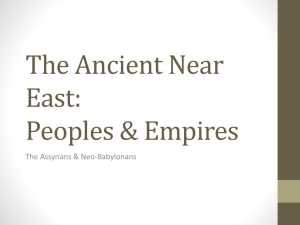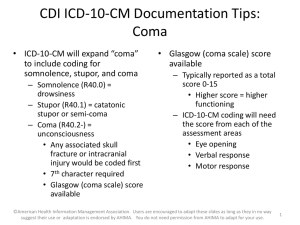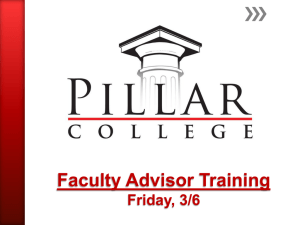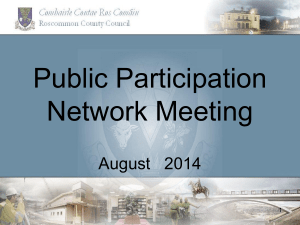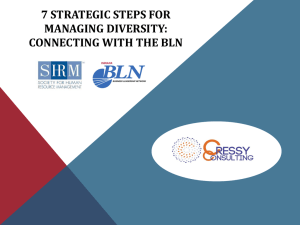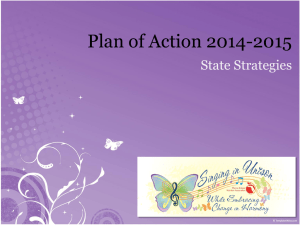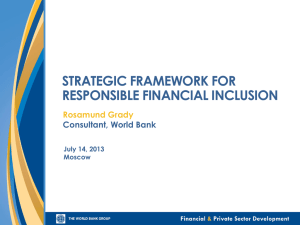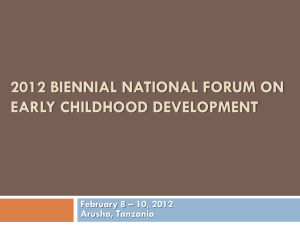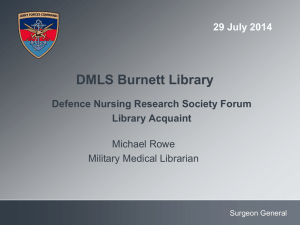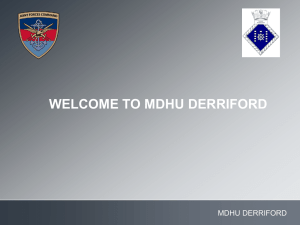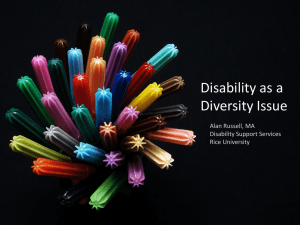Power Point Presentation for Information Stage
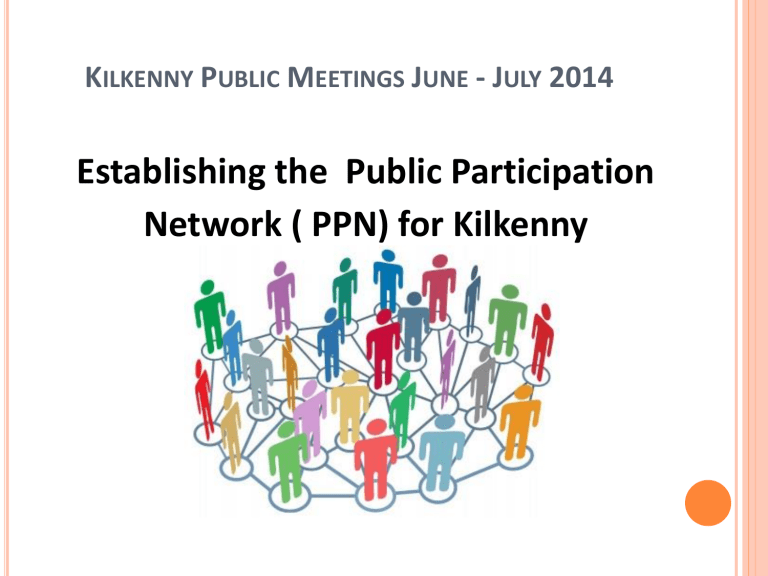
K ILKENNY P UBLIC M EETINGS J UNE - J ULY 2014
Establishing the Public Participation
Network ( PPN) for Kilkenny
B ACKGROUND – K EY P OLICY / R EPORTS
Better Local Government 1996
White Paper on Framework for
Supporting Voluntary Activity and
Developing the relationship between the
State and the Community & Voluntary
Sector (2001)
Local Government Act 2001- Section 127
Taskforce on Active Citizenship 2007
Putting People First 2012
Working Group on Citizen Engagement with Local Government
Local Government Reform Act 2014 -
Section 46
S ECTION 46 – L OCAL G OVERNMENT
R EFORM A CT 2014
Enables Local Authorities to take all appropriate steps to consult with and promote effective participation of local communities in local government
Adoption by each local authority of a framework for public participation in each local government
(Reserved Function)
In accordance with regulations under the Act & the issuance of guidelines from the Department
Set out the mechanisms by which citizens and communities will be encouraged and supported to participate in the decision making processes of the
Local Authority.
W ORKING G ROUP ON C ITIZEN
E NGAGEMENT WITH L OCAL G OVERNMENT
Set up in September 2013
Chaired by Fr. Sean Healy
Role of group – ‘ to make recommendations on more extensive and diverse input by citizens into the decision making at local government level
Report published on February 28 th , 2014 which outlines the framework for public participation in the form of Public Participation Networks http://www.environ.ie/en/Publications/Communit y/CommunityVoluntarySupports/
P UBLIC P ARTICIPATION N ETWORK (PPN)
To be developed in each
Local Authority area - to enable the public to take an active formal role in relevant policy making and oversight committees of the Local
Authority
Main link through which the
Local Authority connects with Community&
Voluntary, Social Inclusion &
Environmental sectors
PPN - O UTLINE OF S TRUCTURE
Organised at
Municipal District Level
County / City Level
Each PPN will have
A Municipal District Plenary which deals with issues at a municipal level
A County / City Plenary which deals with county/city issues
Linkage Groups which deal with specific issues
A secretariat at county / city level that is a facilitation and communication mechanism
Made up of all registered
Community /Voluntary,
Social Inclusion &
Environment Groups within
Municipal District
General Rules:
1. The Plenary is the ruling body
2. Plenary meet formally twice a year
3. One vote per group
Work together on agreed objectives / issues of the
Municipal District
Member groups can be members of County PPN
Plenary of MD nominates one person to the
Secretariat
Plenary is the ruling body
•
All member represented
• on plenary implementation of decisions of plenary
Environment
Social
Inclusion
Community
One group one vote
Plenary meet formally twice annually pillars
21 days notice of meeting
Secretariat
• 1 nominee from each of 4 Municipal
Districts groups present & min 4 secretariat
• Meet at least 4 times per year
C OUNTY PPN
All registered groups in the county are members of the County PPN
The PPN will be the main channel through which people will be selected to participate in various processes of the Local Authority and their Boards
/ Committees
Participants will be chosen by the PPN and should not be rejected by the Local Authority or any of its structures
C OUNTY PPN M EMBERSHIP
Groups must register annually
Register by an agreed date in any given year in order to have voting rights in the following year
Member groups when joining the
PPN at county level must opt to be part of one of three electoral colleges
– Environment, Social Inclusion &
Community/Voluntary
One County Register for all
Environment, Social Inclusion and
Community/Voluntary Groups – a copy of which will be maintained by the Local Authority in accordance with the LG Act 2001
L INKAGE G ROUPS
Central to ensuring that
All member groups are enabled to participate in shaping decisions that are being developed by any structure of the County / City Council
All member groups play a direct role in choosing their participants in the County / City Council
Structures addressing particular issues
The view of all those involved will be communicated
All member groups will be fully up to date with developments in all of these county / city structures
Linkage
Groups
Local
Authority
R OLE OF THE PPN
Main link for local authority to connect with the community, social inclusion and environmental sectors
Facilitate and enable Community Groups to articulate a diverse range of views and interests not to reduce or homogenise this diversity.
Make positive contributions within the local government system
R OLE OF THE PPN
Facilitates input LA through a structure that ensures public participation and representation
Acts as a hub around which information is distributed and received
R OLE OF THE PPN
Help create countywide vision for the well-being of this and future generations
To facilitate opportunities for networking, communication and the sharing of information
To identify issues of collective concern and work to influence policy locally in relation to these issues
To actively support the inclusion of socially excluded groups
R OLE OF THE PPN
Facilitates the selection of participants from the 3 pillars onto city/county decision making bodies.
Seek recognition and acknowledgement of the sector
Create a sense of solidarity and a
strong collective voice within the County
Support nominated representatives to participate effectively
and have their voices heard through the linkage group structure
S TATE S UPPORTS FOR PPN
Local Authorities to agree and adopt an engagement Protocol for all committees/decision making committees with PPN representatives
Local Authorities to set aside resources to cover travel and subsistence expenses for
PPN representatives on LA committees
Local Authorities to facilitate access to a library of relevant thematic documents
Local Authorities to provide for one whole time equivalent staff
member and office space for the Network.
S TATE S UPPORTS FOR PPN
Local Authorities to provide programme funding for the PPN to :
Develop a work plan
Roll out 4 newsletters per year
Develop web site/social media tools
Provide training supports representatives
Local Authorities prioritise resources to those who are most vulnerable and/or whose voices are least heard
O VERSIGHT , M ONITORING AND E VALUATION
The work of the PPN will be monitored and evaluated regularly in line with best practice.
The focus of this oversight will be an assessment of whether or not they re achieving their overall purpose of facilitating
engagement with the local authority and whether the structures, systems and processes are supporting the achievement of that purpose.
THE PILLARS ( C OLLEGES )
Environment, Social Inclusion,
Community
C RITERIA FOR E NVIRONMENT P ILLAR
C RITERIA FOR E NVIRONMENT P ILLAR
C RITERIA FOR E NVIRONMENT P ILLAR
Introduction
C RITERIA FOR S OCIAL I NCLUSION P ILLAR
The National Action Plan for Social Inclusion 2007 – 2016
(NAP inclusion) represents a wide-ranging and comprehensive programme of action to address social exclusion.
It sets out a coherent and comprehensive approach for a ten year period that coincides with the timescale of
Towards 2016 Partnership Agreement.
C RITERIA FOR S OCIAL I NCLUSION P ILLAR
The NAPS lifecycle approach places the individual at the centre of policy development and delivery
Offers a framework for implementing a streamlined, cross-cutting and visible approach to tackling poverty and social exclusion.
In developing criteria for the Social Inclusion Pillar of the
Kilkenny Public Participation Network it is useful to apply these lifecycle thematic headings in the self –selecting of local groups working in Kilkenny.
C RITERIA FOR S OCIAL I NCLUSION P ILLAR
The National Anti-poverty Plan 2007-2016 lifecycle stages
Children;
People of working age;
Older people; and
People with disabilities.
In addition, the NAP inclusion contains a chapter on communities which targets those who experience:
1. Educational Disadvantage
2. Unemployment
3. Income Adequacy
4. Disadvantaged Urban Dwellers
5. Disadvantaged Rural Dwellers
6. Housing/Accommodation issues
7. Health; mental health issues
C RITERIA FOR S OCIAL I NCLUSION P ILLAR
Cross-Cutting Themes are also identified as:
Child Poverty
Women’s Poverty
Older People
Ethnic Minorities including Travellers
People with Disabilities
G UIDELINE FOR C RITERIA FOR S OCIAL I NCLUSION P ILLAR
Eligibility Criteria for membership of the Social Inclusion Pillar
The primary objectives and activities must focus on poverty reduction, community development, equality and social justice issues
The organisation must be a not for profit group
The organisation must be formally organised with at least a constitution, bank account or credit union account
The organisation must have activities in line with a social
inclusion approach to community building and have those who experience poverty and social exclusion on its management
/organisational structure
The organisational structure of the member groups must not have representatives appointed by any government department, semistate body or local authority; but this does not prevent any person sitting on the board in a personal capacity.
C RITERIA FOR S OCIAL I NCLUSION P ILLAR
Suggested list of eligible local groups for membership of the Social Inclusion Pillar
Disability groups
Traveller groups
Ethnic minority groups
Women’s Groups
Family Support Group (FRC’s)
Literacy groups
Older peoples groups
Social justice groups
Groups promoting equality
LGBT Groups
Youth service and groups
Children services and support groups
Suggested list of eligible local groups for membership of the Social Inclusion
Pillar
Groups supporting engagement and participation on inclusive activity, sports, arts, men’s sheds etc...
Mental health / suicide prevention groups
Drug and alcohol support &
Information groups
Advocacy and information groups
Community Development groups
Rural isolation and disadvantage groups
Urban disadvantage groups
C RITERIA FOR C OMMUNITY P ILLAR
Introduction
The national framework for the community pillar best lies with the White Paper on a Framework for Supporting
Voluntary Activity -Developing the Relationship between the State and the Community and Voluntary 2000 and the
Working Group on Citizen Engagement with Local
Government 2013
Community pillar can refer to activity that is intended to promote goodness or improve human quality of life and community well- being
Volunteering as a core aspect within the community pillar
Skills development, socialisation, meeting a particular need as well as creating fun and enjoyment in the community.
G UIDELINE FOR C RITERIA FOR C OMMUNITY P ILLAR
Eligibility Criteria for membership of the Community Pillar
The primary objectives and activities must focus on community responses to locally identified issues/concerns
The organisation must be a not for profit group
The organisation must be formally organised with at least a constitution, bank account or credit union account
The organisation must have activities that promote overall community well being
The organisational structure of the member groups must not have representatives appointed by any government department, semi-state body or local authority; but this does not prevent any person sitting on the board in a personal capacity.
C RITERIA FOR C OMMUNITY P ILLAR
Suggested list of eligible local groups for membership of the Social
Inclusion Pillar
Residents groups
Self-help groups
Community councils
Issue based groups – community infrastructure
Youth groups
Community Associations
Sporting / leisure clubs/groups
Voluntary campaign groups
Arts groups
Broad based service provision groups
Active retirement groups
Festival groups
Playground associations
K
ILKENNY
Steps & Timeframe for establishment of Public Participation Network
Kilkenny County Council Community & Culture Section
Public Information Meetings about Public Participation Networks
Kilkenny County Council Community & Culture Section is hosting a series of information sessions to support the Community,
Social Inclusion and Environment Sectors in establishing the new Public Participation Networks; the new framework for public participation and engagement in local decision making.
General Information meetings Tuesday 3 June, 7.30 PM Kilkenny River Court Hotel, Kilkenny
(Please note this meeting will be supported by Sign Interpreter)
Wednesday 4 June, 7.30PM Athenaeum House Hotel, Ferrybank, Co. Kilkenny
Municipal District Information meetings:
•North MD: Thursday 26, June , 7.30PM Castlecomer Demesne, Castlecomer, Co. Kilkenny
•West MD: Wednesday 2, July , 7.30 PM Friary Hall, Callan, Co. Kilkenny
•East MD: Wednesday 9, July , 7.30PM Thomastown Community Centre, Thomastown Co. Kilkenny
•South MD: Tuesday15 July, 7.30PM Piltown Community Hall, Piltown , Co. Kilkenny
County Wide Plenary
•Wednesday 30July, 7.30 PM Kilkenny River Court Hotel, Kilkenny
For Further information contact email: community@kilkennycoco.ie
or tel: 0567794931
Public Seminar
Monday July 21, 2014 @7PM, Hotel Kilkenny
Dr. Sean Healy-Social Justice Ireland www.socialjustice.ie
Michael Ewing - National Environment Pillar www.environmentpillar.ie
The seminar aims to provide further in depth information and discussion about the new Public Participation Networks- the new
framework for public participation and engagement in local decision making.
County Wide Plenary- Public meeting
Wednesday 30 July, 7.30 PM Kilkenny River Court Hotel,
Kilkenny
Invites to registered groups
Facilitated session to support the group(s) to identify next steps for the establishment of the Kilkenny PPN
T HANK YOU ! A NY Q UESTIONS OR CLARIFICATIONS ?
